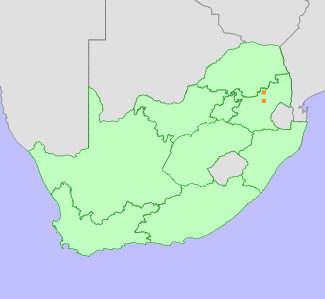|
Scientific Name | Adenia wilmsii Harms |
Higher Classification | Dicotyledons |
Family | PASSIFLORACEAE |
National Status |
Status and Criteria | Endangered D |
Assessment Date | 2022/07/20 |
Assessor(s) | L. von Staden, R.H. Archer & S. Krynauw |
Justification | A rare, range-restricted species with an extent of occurrence (EOO) of 95 km², known to occur at two locations. At one location, a thorough search could only locate 20 plants and about 50 plants have been reported to occur at the other. Two historical subpopulations cannot be relocated and are presumed extinct. This species is used in traditional medicine, but only the leaves were confirmed to be used at one site, and harvesting pressure, if any, at the other site is not known. It is therefore listed as Endangered under criterion D. |
Distribution |
Endemism | South African endemic |
Provincial distribution | Mpumalanga |
Range | This species is endemic to the Mpumalanga province, where it occurs from Lydenburg to Waterval Boven. |
Habitat and Ecology |
Major system | Terrestrial |
Major habitats | Steenkampsberg Montane Grassland, Lydenburg Thornveld |
Description | It grows on dolerite outcrops or red loam soil, in open woodland, at an altitude of 1300-1500 m. |
Threats |
| The roots, bark and leaves of Adenia species are harvested for medicinal purposes (Venter 1993). When this species was pointed out to a local community on the farm Rooidraai, they confirmed that it is harvested for medicinal purposes (M. Lötter, pers. comm.), however they only confirmed using the leaves. The ridge where this plant is found is surrounded by scattered settlements, and it is likely that all individuals are equally vulnerable to harvesting (J. Burrows, pers. comm.). Some individuals/subpopulations were lost in the past due to urban expansion of Lydenburg. Further habitat loss to urban expansion is however not a serious ongoing threat (M. Lotter and J. Burrows pers. comm.). |
Population |
One continuous subpopulation occurs along a ridge of ca 19 km². A search over the whole Rooidraai Ridge revealed very few individuals (about 20). The plant occurs very sparsely among rocky areas. A second subpopulation on a farm near Waterval Boven contains about 50 plants.
|
Population trend | Stable |
Conservation |
| It is not currently conserved in any formally protected area. |
Assessment History |
Taxon assessed |
Status and Criteria |
Citation/Red List version | | Adenia wilmsii Harms | EN D | Raimondo et al. (2009) | | Adenia wilmsii Harms | Insufficiently Known | Hilton-Taylor (1996) | |
Bibliography |
De Wilde, W.J.J.O. 1976. Passifloraceae. In: J.H. Ross (ed). Flora of southern Africa 22:104-128. National Botanical Institute, Pretoria.
Hilton-Taylor, C. 1996. Red data list of southern African plants. Strelitzia 4. South African National Botanical Institute, Pretoria.
Raimondo, D., von Staden, L., Foden, W., Victor, J.E., Helme, N.A., Turner, R.C., Kamundi, D.A. and Manyama, P.A. 2009. Red List of South African Plants. Strelitzia 25. South African National Biodiversity Institute, Pretoria.
Venter, S. 1993. Notes on the genus Adenia with special reference to the Transvaal species. Aloe 30(3/4):83-89.
|
Citation |
| von Staden, L., Archer, R.H. & Krynauw, S. 2022. Adenia wilmsii Harms. National Assessment: Red List of South African Plants version 2024.1. Accessed on 2025/11/18 |
 Comment on this assessment
Comment on this assessment


